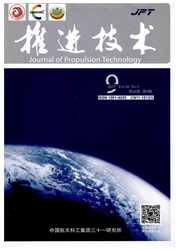

 中文摘要:
中文摘要:
液滴蒸发、燃烧过程均对温度变化较为敏感,为了获得液滴燃烧释热过程对于温度振荡的响应特性,对庚烷液滴气液两相燃烧问题进行了数值模拟。主要分析了来流温度振荡频率分别为2k Hz,5k Hz和10k Hz,温度振荡幅值分别为5%,10%和15%时,液滴燃烧过程中释热速率振荡幅值及相位差变化规律,同时考察了液滴直径变化产生的影响。结果表明,释热速率振荡幅值随着来流温度振荡频率和振荡幅值的增加而大幅升高;释热速率波动与来流温度振荡之间的相位差受温度振荡频率影响较大;改变液滴直径可以有效控制释热响应特性,相同工况下,减小液滴直径会使得释热振荡幅值显著降低;由于温度振荡与液滴的蒸发和释热之间的相互影响,使得在部分工况下液滴燃烧释热响应特性出现了显著的非线性特征。
 英文摘要:
英文摘要:
The droplet evaporation and combustion processes are very sensitive to temperature. In order to obtain the response characteristics of heat release to temperature oscillation while fuel droplet combustion, the two-phase reaction of fuel droplet of heptane has been numerically investigated. The variations of amplitude and phase angle of heat release rate are mainly studied at the flow temperature oscillation frequency of 2kHz, 5kHz and 10kHz and oscillation amplitude of 5%, 10% and 15%, and the effects of droplet diameters are also consid- ered at the same time. The simulation results indicate that, the amplitude of oscillation of heat release rate increases greatly with the increases of the frequency and amplitude of flow temperature oscillation. The phase difference of temperature oscillation and heat release rate oscillation appears to be mainly influenced by the frequency of temperature oscillation. The change of droplet diameter could effectively influence the dynamic heat release response characteristics, and at the same condition, the amplitude of heat release rate oscillation decreases while the droplet diameter becomes smaller. With the interaction within temperature oscillation, evaporation and heat release processes, droplet combustion heat release appeared significant non-linear characteristics in some conditions.
 同期刊论文项目
同期刊论文项目
 同项目期刊论文
同项目期刊论文
 期刊信息
期刊信息
